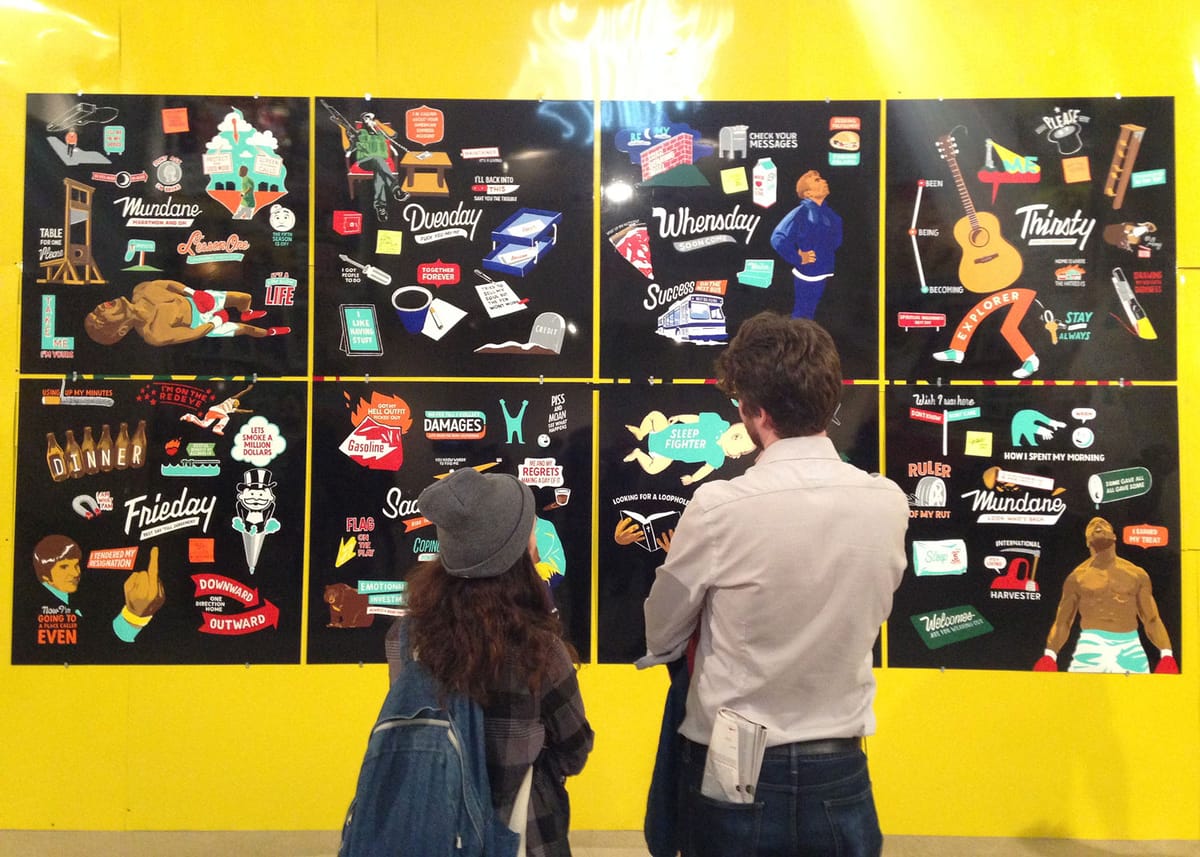On Display Now: Tribute To Coney Island Signs At Brooklyn Museum

Whether you are walking in and out of the galleries of Bushwick, perusing the graffiti art of storefront metal gates on Avenue U or stepping over thoughtful spray paint stencils on your local street corner, this borough’s creativity is effused throughout its infrastructure. This often neglected urban art is reconsidered and given a more thoughtful home on the Brooklyn Museum’s fifth floor with Stephen Powers: Coney Island is Still a Dreamland (To a Seagull), on display now through August 21.
For the past four months Powers has been setting up shop in the Iris and Gerald B. Cantor Gallery, a vast room with ceilings that reach to the sky. The cavernous space is put to good use with floor to ceiling installations of hand painted signage and advertisement that serve as a love letter to the iconography of 150 years of visual entertainment on the Coney Island boardwalk. The flashy, bold colors of posters, large and small, compete for space and viewers’ attention as if the gallery walls were a common bulletin board. Powers creates a space that is loud, confrontational and as pushy as a hundred vendors vying for your attention along the boardwalk. In the center of the space there is a single coin-operated tower viewer; unnecessary for the bold, communicative work on the wall, but evoking the feeling that beyond the consumerist menagerie there is an ocean view, stretches of sand, maybe a swooping seagull somewhere in the distance.

Powers has been mixing art and industry in NYC for decades as a graffiti artist working, in a sometimes contentious relationship with the law, to paint over the metal grates of abandoned or defaced storefronts. In 2000 Powers began his relationship with Coney Island when he curated an installation called “The Dreamland Artists Club,” to redesign and paint storefront signs along the Coney Island boardwalk. His business in Park Slope, ICY signs, also blends functionality and creative passion by offering a commercial sign shop and serving as a studio space on the corner of Fourth Avenue and Bergen Street.
If you get lucky, you may catch Stephen Powers or another artist at work creating a new sign, performing fast and tight brushwork, mostly unaware of passerby. When I was there a man was speedily crafting a sign for something that would cost “ONLY 5 ¢!” although I got the sense it would never be clear what exactly cost five cents. The insightful experience in viewing this work is that there is no mention of brand, not much about product, and in the absence of knowing what to consume we can thoughtfully consider how advertising plays with our focus and desire. Meanwhile, when Powers removes the intention from the ad it is free to take on an aesthetic beauty that is normally stripped by product placement.
The impetus for this installation is the 150th anniversary of Coney Island as a tourist attraction. It was presented in conjunction with Coney Island: Visions of an American Dreamland, 1861–2008 — which has since ended — but the appeal of Stephen Powers’ work was strong enough to extend its run until August.
Coney Island is a global historical landmark and a precursor to the theme parks of modernity but it means something entirely different to locals. Coney Island claims a special place in the hearts of many Brooklynites, less for its amusements and more for its strange, otherworldly qualities: its winter solitudes, fisherman hangouts, and the landmarked Parachute Jump’s cloud slicing figure on the south Brooklyn skyline. At the same time it is a contentious area where seasonal disregard and degradation can leave residents feeling forgotten. It is in this regard that Powers’ work comes off tone deaf and inconsiderate. All of the speed and ferocity of a busy summer can be captured in this installation but there is little evidence in his work of the closed up shops and leftover detritus of a long summer season, or the strange feeling a child gets when passing by a remastered sign inviting you to “shoot the freak.”
Powers’ installation is worthy of a trip, although not for any specific piece of work or even the grandiose way he throws it together in what seems like acres of two-dimensional visual product. What is exceptional about this installation is that it unlocks a new way of looking at the most common pieces of art we see every day: the advertisements and signs that command our attention. After considering the art of advertisement it brings meaning to the strips of 99 cent stores, take out restaurants and cell phone outlets that populate our daily commutes for better or worse. If nothing else, let this installation lend a moment of generosity to the way you absorb your surroundings.
Stephen Powers: Coney Island Is Still a Dreamland (To a Seagull) is open through August 21, 2016 at the Brooklyn Museum, 200 Eastern Parkway Brooklyn, New York 11238




